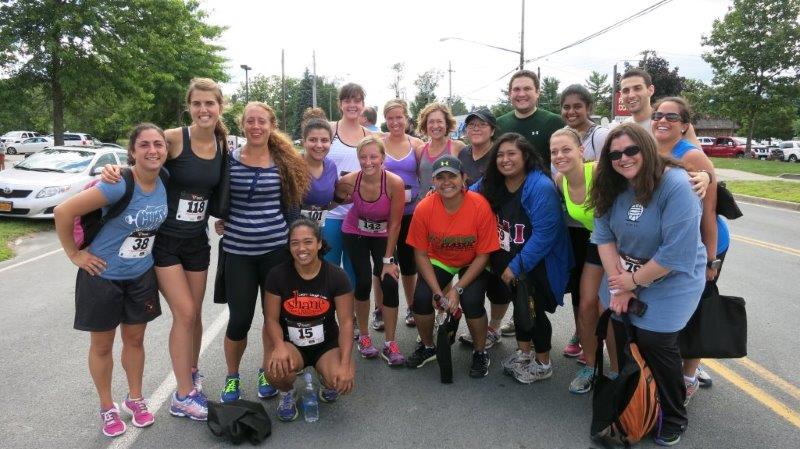
Distance races like 10Ks, half marathons and adventure races like Tough Mudders and Color Runs are more popular than ever. People enjoy getting their competitive juices flowing, which helps them want to get fitter, faster and in the best shape as possible, especially with the warmer temperatures heading our way. Even those who have haven’t run since high school gym class are signing up and lacing up for new and popular races all over the country. I tell my clients that as long as you find something that makes physical activity fun, go for it!

For this post, I teamed up with Bryn Roberts from Wynsors to help you go into your race training safely and effective while fueling your body in the best way possible. Here’s what Brynn has to say:
Those winter blues have thawed away. The weather is warm, the land is green and the air is fresh. spring is in! Now that the blistering cold has left but the sizzling heat of summer is yet to come, it is the perfect time to develop a running routine without the extremities of weather getting in your way.
If you are thinking of getting into distance running then there is no better time to start. We have put together an 8 week guide to help beginner runners know what to expect on their way to a fitter future:
WEEKS 1 & 2
The first couple of weeks is all about getting your body used to the sensation of running and into shape. If you have never done distance running before then this period will gradually introduce it to your body so it can become accustomed to the demands of sustained exercise. During these weeks you should not be concerned about your times and only aim to use approximately 1/3 of your maximum effort.
WEEK 3 & 4
By now you should be comfortable with the demands distance running asks of your body. As a result you will find you have more energy. You will need to use this to increase your output to about ½ of your maximum effort. Although your body is adapting you will need to make sure you are also mentally prepared for the increase in exercise.
WEEK 5 & 6
At the beginning of this time it may feel like you are having to push yourself again, but it will soon fade as your body quickly adjusts to the next level of distance running. Just be sure to keep yourself hydrated and you will break through it.
WEEK 7 & 8
All your hard work is now paying off! Be sure to ‘listen’ to your body when you are doing the longer runs during these weeks. Being attuned to your body’s needs and limits you will now have learned to pace yourself across the run so that you don’t slow down or burn out towards the end. If you are preparing for a race then be sure to reduce your times in these weeks as your body will need to recover before the big run.
More detailed guides for marathon, half-marathon & 10k training plans with advice on timings for various degrees of difficulty, is available on the Wynsors site.
Acclimatising your body is vital to a successful run, however exercise is only part of the training. In order to fully adapt to distance running you also need to sort out your diet.
And he’s right.
After your run, you have a 30- 45 minute window to get in the right nutrients and acheive optimal recovery for your muscles. You’ve all heard that protein is important for recovery, but carbohydrates also help to refuel energy stores and allow your body to produce insulin, a hormone that contributes to muscle building. The trick is to get in the right kind of carbohydrates; from fruits, dairy or whole grains instead of simple sugars. Quinoa and old-fashioned oatmeal are two high fiber, high protein sources of healthy carbohydrate to incorporate into a post-workout meal or snack.
You’ve probably know that antioxidants help prevent cancer and heart disease, but did you know they also reduce inflammation and alleviate muscle soreness? Fruits and vegetables are the best sources of antioxidants. The more color on your plate, the better.
Check out my recipe for Protein Packed Pizza Bites for a perfect post-run snack. They’re high in protein from the eggs and the quinoa and packed with nutrients and antioxidants from the onion, tomatoes, garlic and herbs.
If you tend to not have an appetite following a run, liquid meals or snacks are a perfect remedy. Try making your own smoothies at home with plain Greek yogurt and frozen berries. Beware of smoothies from chains or fast food restaurants, as they may contain upwards of 800 calories and 60 grams of sugar (a whole days worth)!

One drink that is loaded with antioxidants and has been shown to reduce muscle soreness is tart cherry juice. A study published in the Scandinavian Journal of Medicine found that drinking tart cherry juice following strenuous exercise reduces inflammation and aids in the recovery of muscle function. Studies conducted using watermelon and watermelon juice have also shown similiar results. Try blending tart cherry juice or seedless watermelon chunks into a smoothie for an anti-inflammatory boost.
If you would like more personalized nutrition advice or a plan specific to your goals and calorie needs, contact me at meganwarerd@nutritionawareness.com. Happy running!
